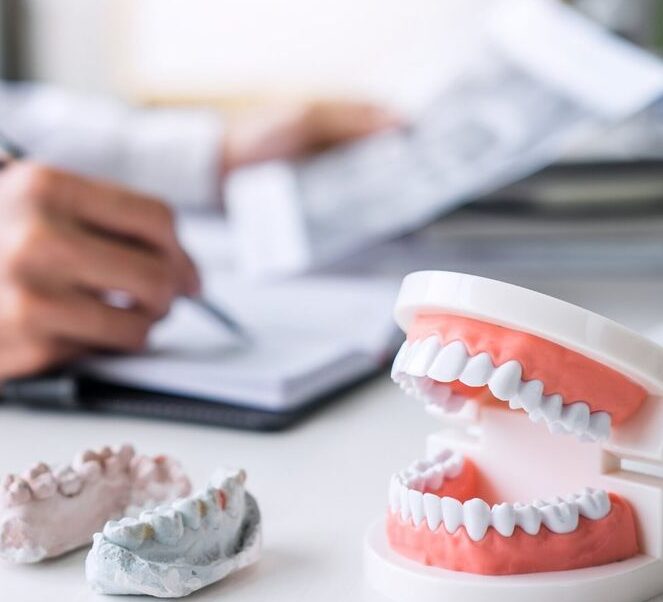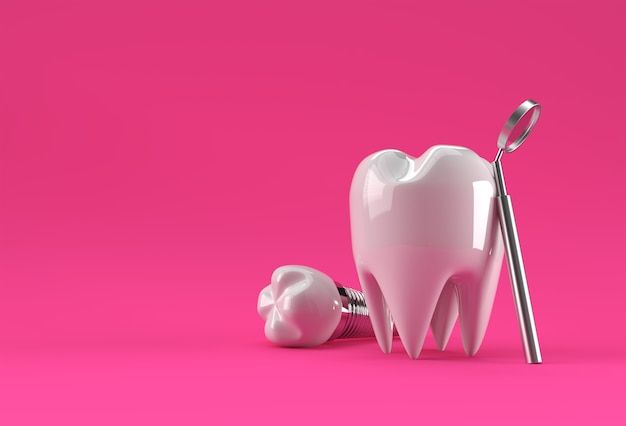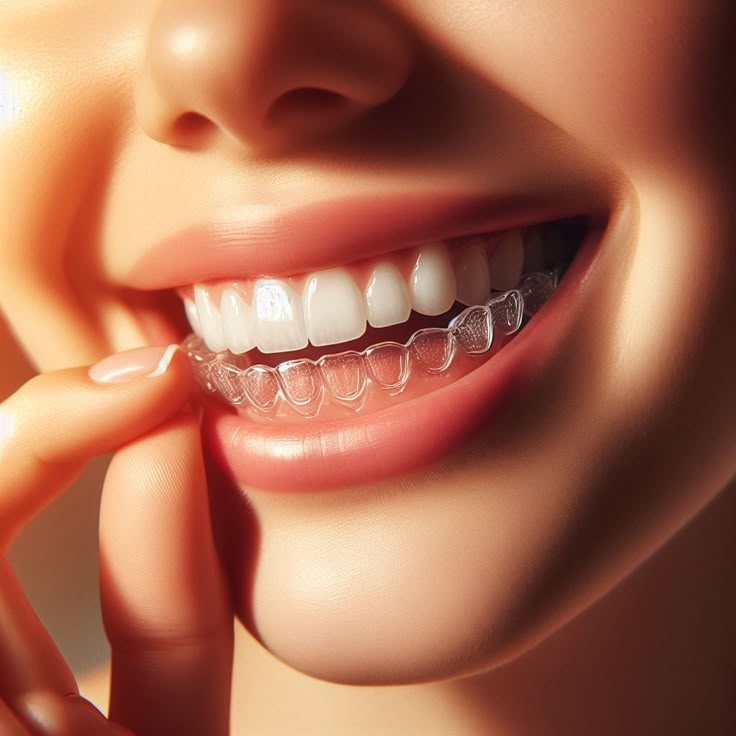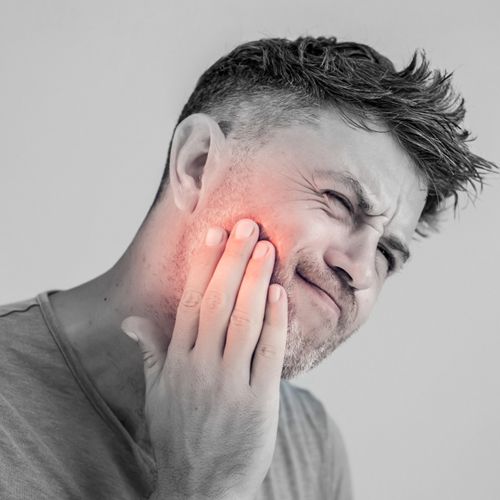A half denture, also known as a partial denture, is a removable dental appliance designed to replace missing teeth in a specific section of the mouth while preserving the natural teeth that remain. 1. Restores Functionality Chewing: It allows you to chew food more effectively, which improves digestion and overall nutrition. Speaking: It helps in better pronunciation of words, as missing teeth can sometimes cause speech issues. 2. Enhances Appearance Aesthetic Appeal: Partial dentures fill gaps in your smile, improving facial aesthetics and boosting self-confidence. Prevents Sagging: Missing teeth can lead to sagging facial muscles; partial dentures provide support to the facial structure. Partial Dentures Partial dentures are prosthetic devices designed to replace one or several missing teeth in either the upper or lower jaw. They consist of replacement teeth attached to a gum-colored base, often made from acrylic or metal, which blends seamlessly with the natural gum line. Flexible Partial Dentures: Constructed from a flexible, gum-colored material, these dentures offer enhanced comfort and aesthetics, as they adapt more naturally to the contours of the mouth. Implant-Supported Partial Dentures: For increased stability and reduced movement, implants can be surgically placed in the jawbone to support the partial denture, creating a more secure fit.
Tooth extraction
Tooth extraction is a dental procedure in which a tooth is removed from its socket in the bone. This can be necessary for a variety of reasons, including severe decay, infection, crowding, or trauma. Here’s an overview of the process, reasons, preparations, and post-procedure care. 1. Reasons for Tooth Extraction Tooth Decay or Infection: When a tooth is severely decayed or infected, extraction may be needed to prevent the infection from spreading. Crowding: Orthodontic treatments, such as braces, sometimes require the removal of a tooth to align teeth properly. Impacted Teeth: Wisdom teeth are often impacted, meaning they do not fully emerge from the gums and may require extraction. Periodontal (Gum) Disease: Severe gum disease can damage the supporting tissues and bone, making extraction necessary. 2. Types of Tooth Extractions Simple Extraction: This is performed on a tooth that is visible in the mouth and usually involves loosening the tooth with an instrument called an elevator, then removing it with forceps. Surgical Extraction: For teeth that are not visible (e.g., impacted teeth), an oral surgeon makes an incision in the gum to access and remove the tooth. 3. Preparation Examination: The dentist will take X-rays to evaluate the position and condition of the tooth. Medical History: You’ll need to inform the dentist of any medications, supplements, or existing medical conditions. Anesthesia: Local anesthesia is usually administered for a simple extraction, while surgical extractions may require sedation or general anesthesia. 4. Procedure Simple Extraction: After numbing the area, the dentist loosens the tooth with an elevator and then removes it with forceps. Surgical Extraction: The oral surgeon makes an incision in the gum, may remove bone around the tooth, and extracts it in sections if necessary. 5. Aftercare Bleeding Control: You’ll bite down on gauze to help stop bleeding, which should subside within a few hours. Pain Management: Over-the-counter pain relievers or prescribed medications help with pain and swelling. Avoid Rinsing: For the first 24 hours, avoid rinsing your mouth to prevent dislodging the blood clot. Diet: Soft foods are recommended for the first few days, and avoid using straws, as the suction can disturb the clot.
Baby milk Teeth
Baby (or primary) teeth, also known as milk teeth, play a crucial role in a child’s early development. They not only aid in eating and speaking but also hold space in the jaws for the permanent teeth that will come in later. The My Teeth Dental in Webstar is conveniently located near to the Lake Campus Hospital Complex and NASA Johnson Space center is the best dental office near you for any type of Dental problem . Here’s a detailed look at baby teeth: The Brownfield dentist in Brownfield is conveniently located near to the Brownfield Sport Complex and Coleman Park is the best option available for any type of Dental Problem regarding baby teeth care . 1. Number and Types of Baby Teeth Total: A full set includes 20 primary teeth: 10 on the top and 10 on the bottom. Types: Incisors (8): The four front teeth on the top and bottom, used for biting. Canines (4): Located next to the incisors, these teeth help with tearing food. Molars (8): At the back of the mouth, they grind food. 2. Eruption Timeline First Tooth: Usually appears between 6–10 months of age. Teething Period: Most children get all their baby teeth by the time they’re 2–3 years old. Order: Typically, the lower central incisors come in first, followed by the upper central incisors, then the lateral incisors, canines, and molars. 3. Functions of Baby Teeth Chewing and Nutrition: Allow the child to chew a variety of foods, contributing to balanced nutrition. Speech Development: Help children learn to make sounds and articulate words clearly. Jaw Growth and Alignment: Guide the jaw’s growth and ensure proper spacing for permanent teeth. Confidence: Healthy baby teeth help with a child’s self-esteem by contributing to a complete, comfortable smile. 4. Baby Teeth Care and Maintenance Brushing: Begin brushing with a tiny, soft-bristled toothbrush as soon as the first tooth emerges, using a grain-sized amount of fluoride toothpaste. Flossing: Start flossing once two teeth touch. Diet: Limit sugary foods and drinks, as these can contribute to tooth decay. Regular Dental Visits: A dental check-up is recommended by the time the first tooth appears or by the child’s first birthday. Call us at 281-672-7178, Mail us at : myteethdentaltx@gmail.com or visit myteethdentaltx.com to schedule your appointment. Find us at: 1199 blossom street Webstar, TX 77598.
Dental extraction
More complex than a simple extraction. It may require an incision in the gum, and in some cases, the tooth may need to be broken into pieces for easier removal. Dental extraction is the process of removing a tooth from its socket in the bone. While dentists aim to preserve natural teeth whenever possible, extractions are sometimes necessary due to disease, trauma, or other oral health concerns. Types of Dental Extractions: Simple Extraction: Performed on: Teeth that are visible in the mouth, typically when they are intact and not too damaged. Procedure: The dentist numbs the area with local anesthesia and uses an instrument called an elevator to loosen the tooth, then removes it with forceps. Surgical Extraction: Performed on: Teeth that are not easily accessible, such as impacted teeth (often wisdom teeth) or teeth broken at the gum line. Procedure: More complex than a simple extraction. It may require an incision in the gum, and in some cases, the tooth may need to be broken into pieces for easier removal. This procedure is often done under local anesthesia with sedation, or sometimes general anesthesia. Reasons for Dental Extractions: Severe Tooth Decay or Infection: When a tooth is too badly damaged by decay or infection to be repaired with a filling, crown, or root canal treatment, extraction may be necessary. Periodontal (Gum) Disease: Advanced gum disease can loosen teeth or severely damage the surrounding bone, making extraction the best option. Crowded Mouth: Sometimes teeth are removed to make room for orthodontic treatment, especially when the mouth is too small to accommodate all the teeth properly. Call us at 281-672-7178, Mail us at : myteethdentaltx@gmail.com or visit myteethdentaltx.com to schedule your appointment. Find us at: 1199 blossom street Webstar, TX 77598.
Clear Aligners
Invisalign is a popular brand of clear aligners used as an alternative to traditional braces for straightening teeth. It consists of a series of custom-made, nearly invisible plastic trays that gradually shift teeth into their proper positions. Invisalign is a popular brand of clear aligners used as an alternative to traditional braces for straightening teeth. It consists of a series of custom-made, nearly invisible plastic trays that gradually shift teeth into their proper positions. How Invisalign Works: A dentist or orthodontist assesses whether you’re a good candidate for Invisalign. They may take X-rays, photos, and dental impressions to create a 3D image of your teeth. Customized Aligners: Based on the 3D images, a series of aligners is designed specifically for your teeth. Each aligner is worn for about 1-2 weeks and gently moves the teeth to the next stage. Who Might Not Be Suitable for Invisalign? Complex Orthodontic Issues: For severe cases, such as significant bite misalignment, jaw issues, or severe crowding, traditional braces might be more effective. Young Children: Invisalign is typically not recommended for children whose teeth are still growing and developing. Non-Compliant Individuals: Invisalign requires discipline. Those who can’t commit to wearing the trays consistently may not achieve the desired results. Invisalign is a great option for many people looking for a discreet and comfortable way to straighten their teeth. However, a consultation with a dentist or orthodontist is essential to determine if it’s the right solution for you. Call us at 281-672-7178, Mail us at : myteethdentaltx@gmail.com or visit myteethdentaltx.com to schedule your appointment. Find us at: 1199 blossom street Webstar, TX 77598.
Improving the Smile
Cosmetic dentistry focuses on improving the appearance of a person’s teeth, gums, and overall smile. Unlike general dentistry, which addresses dental health and functionality, cosmetic dentistry is more about aesthetics. Teeth Whitening: Purpose: To remove stains and discoloration, giving teeth a brighter appearance. Types: In-Office Whitening: Performed by a dentist using strong bleaching agents for faster results. At-Home Whitening: Custom-made trays with lower-concentration bleaching agents for gradual whitening. Ideal for: People with yellow or stained teeth caused by food, beverages, tobacco, or aging. Dental Veneers: Purpose: Thin, custom-made shells of porcelain or resin that cover the front surface of teeth to improve their appearance. Procedure: A small amount of enamel is removed from the tooth, and the veneer is bonded to the surface. Ideal for: Correcting chipped, broken, discolored, or misaligned teeth. Types: Dental Bonding: Purpose: Repairing chipped, cracked, or discolored teeth using tooth-colored resin. Procedure: The dentist applies a bonding material and shapes it to the tooth, then hardens it with a special light. Ideal for: Small cosmetic changes like repairing chips, closing gaps, or reshaping teeth. Dental Crowns: Purpose: To cover a damaged or decayed tooth to restore its shape, size, strength, and appearance. Procedure: The tooth is reduced in size, and a crown is custom-made to fit over it. Ideal for: Strengthening and improving the appearance of a damaged, decayed, or weakened tooth. Also used after root canals. Cosmetic dentistry can significantly enhance the appearance of your smile while also improving oral health and function. Whether you’re looking to whiten your teeth, repair damage, or undergo a complete smile makeover, a variety of cosmetic dental procedures are available to meet your needs. It is important to consult with a qualified dentist or cosmetic dental specialist to determine the best treatment options for your specific concerns. Call us at 281-672-7178, Mail us at : myteethdentaltx@gmail.com or visit myteethdentaltx.com to schedule your appointment. Find us at: 1199 blossom street Webstar, TX 77598.
Wisdom teeth removal
Wisdom teeth removal is a common dental procedure, often recommended when the third molars (wisdom teeth) become impacted or pose potential problems. Here’s a detailed overview: The Kemah Family Dental, TX which is the best option available and for any type of Dental Care dentist near you. What are Wisdom Teeth? Location: Wisdom teeth are the last set of molars located at the back of your mouth, usually appearing between ages 17 and 25. Purpose: Historically, they helped our ancestors chew tougher foods, but with changes in diet and dental care, many people don’t need them. Reasons for Removal Impaction: Wisdom teeth can become trapped in the jawbone or gums, leading to pain or infection. Crowding: They can push other teeth out of alignment. Decay and Disease: Wisdom teeth are hard to reach for brushing and flossing, increasing the risk of cavities and gum disease. Cysts or Tumors: In rare cases, impacted wisdom teeth can lead to cysts or other complications. The Procedure Consultation: An initial dental exam, often including X-rays, to assess the position of the teeth. Anesthesia: Options include local anesthesia (numbing the area), sedation anesthesia (to relax you), or general anesthesia (to put you to sleep). Extraction: The dentist or oral surgeon will make an incision in the gum tissue. If the tooth is impacted, they may need to remove some bone around it or cut the tooth into smaller pieces for easier removal. Once extracted, the area is cleaned and stitched if necessary. Recovery Post-Operative Care: Rest for the first 24 hours and avoid strenuous activities. Apply ice packs to reduce swelling. Follow a soft food diet (e.g., yogurt, applesauce, mashed potatoes). Stay hydrated and avoid using straws, as suction can dislodge blood clots. Pain Management: Over-the-counter pain relievers or prescription medications may be needed. Follow-Up: A follow-up appointment may be necessary to check healing and remove stitches if non-dissolvable stitches were used. Call us at 281-672-7178, Mail us at : myteethdentaltx@gmail.com or visit myteethdentaltx.com to schedule your appointment. Find us at: 1199 blossom street Webstar, TX 77598.
Dental Emergency
Dental braces for kids are orthodontic devices used to correct misaligned teeth and jaws, improving dental health and appearance. Here are some key points about dental braces for children. The My Teeth Dental in Webstar is conveniently located near to the Lake Campus Hospital Complex and NASA Johnson Space center is the best dental office near you for any type of Dental problem . 1. Tooth injury from a crash: – Teeth can be chipped, cracked, or knocked out due to a collision or impact. – Lacerations to the lips, tongue, or cheeks can also occur. – Quick treatment is crucial to save the tooth and prevent infection. 2. Toothache or abscess: – Severe tooth pain can distract the driver, impairing their focus and reaction time. – An abscess can lead to swelling, fever, and potentially life-threatening complications if left untreated. – Emergency dental care is necessary to alleviate pain and prevent further complications. 3. Dental work dislodged: – Crowns, bridges, or dentures can be dislodged due to the intense forces experienced during racing. – This can cause discomfort, pain, or difficulty speaking and communicating with the team. – Prompt dental attention is needed to reattach or replace the dental work. 4. Gum or jaw injuries: – Trauma to the gums or jaw can occur due to a crash or impact. – This can lead to pain, swelling, and limited jaw movement. – Immediate dental evaluation is necessary to assess and treat the injury. 5. Emergency dental kit: – Racing teams should have an emergency dental kit on hand, including supplies like dental wax, gauze, and pain relievers. – Knowing basic dental first aid can help team members provide initial care until professional help arrives. It’s essential for drivers and racing teams to prioritize dental health and have a plan in place for emergency situations. Regular dental check-ups and preventative care can also help minimize the risk of dental emergencies during competition. Call us at +1-972-351-9110 or visit familysmilestx.com/ to schedule your appointment. Find us at: 1011 N Hwy 77, Ste 105 Waxahachie, Tx.
Cosmetic dentistry
Cosmetic dentistry refers to dental work that improves the appearance of a person’s teeth, gums, and smile. Unlike general dentistry, which focuses on preventing, diagnosing, and treating dental diseases, cosmetic dentistry is primarily about enhancing the visual appeal of your smile.
How to Manage Pain after Root Canal Treatment?
An often performed dental procedure, a root canal treatment is designed to salvage a tooth that is severely damaged or infected. This process entails extracting the infected pulp from the tooth and sealing it off to halt the spread of infection. While root canal treatment is highly effective in alleviating tooth pain and preserving oral health, many patients experience post-treatment discomfort. This article will explore how to manage pain after root canal treatment. What is Post-Root Canal Pain? After undergoing a root canal, some patients may experience discomfort or pain. This pain typically arises from inflammation of the surrounding tissues, especially in cases where the tooth was severely infected prior to treatment. Cleaning and shaping the root canal can also lead to temporary irritation of the surrounding gums and tissues. Additionally, some patients may experience sensitivity or discomfort when biting down due to the restoration placed on the treated tooth. How Long Does the Pain Last After a Root Canal? The duration of post-root canal pain varies from person to person and depends on several factors. In most cases, any discomfort or pain experienced after a root canal should subside within a few days to a week. However, in some cases, especially if the tooth was severely infected or if there were complications during the procedure, the pain may persist for extended periods. Factors that may influence the duration of post-root canal pain include the severity of the infection prior to treatment, the complexity of the procedure, the patient’s overall health and immune response, and adherence to post-treatment care instructions. Immediate Post-Treatment Care Following a root canal procedure, taking proper care of the treated tooth and surrounding tissues is essential to minimize discomfort and promote healing. Here are some immediate post-treatment care instructions: Take prescribed medications exactly as directed by the dentist near you to manage pain and prevent infection. Avoid chewing on the root canal-treated tooth until the numbness wears off to prevent further irritation. Stick to soft food diet for sometime as directed. Apply an ice pack to the outside of the cheek near the treated tooth to reduce swelling and discomfort. Avoid cigar smoking as it slows the healing process. Follow any additional instructions provided by your trusted dentist for caring for the treated tooth and maintaining oral hygiene. Tips for Managing Pain After Root Canal Treatment Avoidance of Hot and Cold Foods Temperature-sensitive foods and beverages, such as hot coffee, ice cream, or cold drinks, can trigger sensitivity in the treated tooth. To minimize discomfort, avoid consuming extreme temperatures and opt for lukewarm or room-temperature foods and drinks instead. Maintain Proper Oral Hygiene While it’s essential to keep the treated area clean to prevent infection, it’s equally important to avoid aggressive brushing or flossing that could irritate the gums or dislodge any temporary fillings. Avoid Strenuous Activities Engaging in strenuous physical activities immediately after a root canal can increase blood flow to the area and exacerbate pain or discomfort. Avoid activities that require heavy lifting, bending, or vigorous exercise for the first few days following treatment. Elevate Your Head After undergoing a root canal, to help alleviate swelling and discomfort, rest with your head elevated on a pillow or other raised surface. This positioning can facilitate the drainage of excess fluids from the treated area. You can accomplish this by using an extra pillow or slightly raising the head of your bed. Beyond just reducing inflammation, this approach may also prevent blood from pooling in your head and neck. Stay Hydrated It’s important for your health to drink enough water, and it can also help your teeth heal after a root canal. Staying wet helps the body get rid of toxins, keeps cells moist, and improves circulation. Drink 7-8 glasses of water every day, and don’t drink too many sugary or caffeine drinks, as they can make you lose water. Ways to Relax and Ease Pain and Anxiety After a root canal, pain and anxiety may linger. Utilizing relaxation techniques can ease discomfort and calm nerves: Deep Breathing: Take a big breath in through your nose, hold it for a moment, and then slowly let it out through your mouth. Repeat this process multiple times. Progressive Muscle Relaxation: As you work your way up to your head, tighten and relax different groups of muscles. This is called progressive muscle relaxation. Guided Imagery: Visualize yourself in a peaceful, serene location. Focus on sensory details like sounds, smells, and sensations. Meditation: Pay attention to your breath or a relaxing phrase to become more aware. Yoga: Gentle yoga poses and stretches can alleviate tension and promote relaxation. Aromatherapy: Relaxing scents include lavender and chamomile. Use essential oils or scented lights to relax. Conclusion In conclusion, while post-root canal pain is a common occurrence, it can usually be managed effectively with proper care and attention. By using the advice in this piece and doing what your dentist tells you, you can ease your pain and speed up the dental healing process after root canal treatment. If the pain after a root canal in Webster, TX, is serious or lasts for a long time, you should call your dentist right away to get more tests and treatment. Don’t forget that your dentist is here to help you with all of your oral health needs. Ready for Relief? Schedule Your Follow-up Appointment Today! Don’t let post-root canal pain hold you back. Schedule a follow-up appointment at Dr. Teeth Dental Care – Webster and take the first step towards relief. Our skilled staff cares about your oral health and will give you specialized care and support to help you deal with pain and speed up the healing process. Our dental services include teeth whitening in Webster and more. We are experts in root canal treatment and aftercare. Get in touch with us right away to make an appointment and enjoy a healthy, pain-free smile again!










